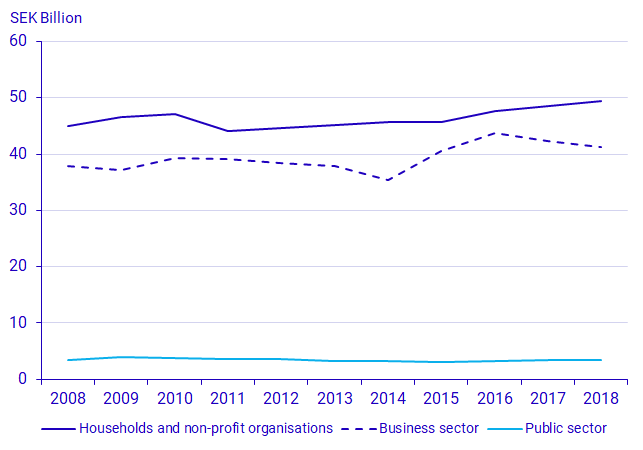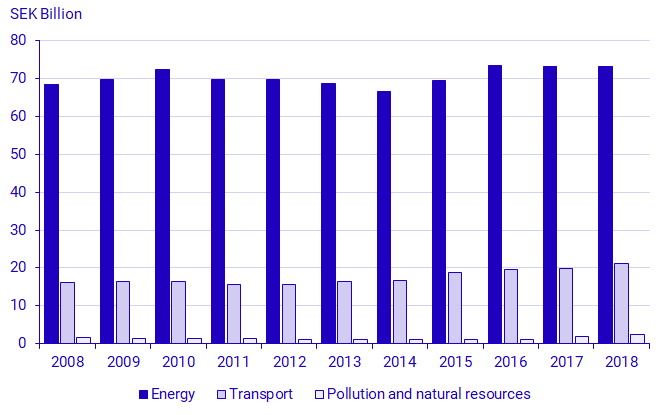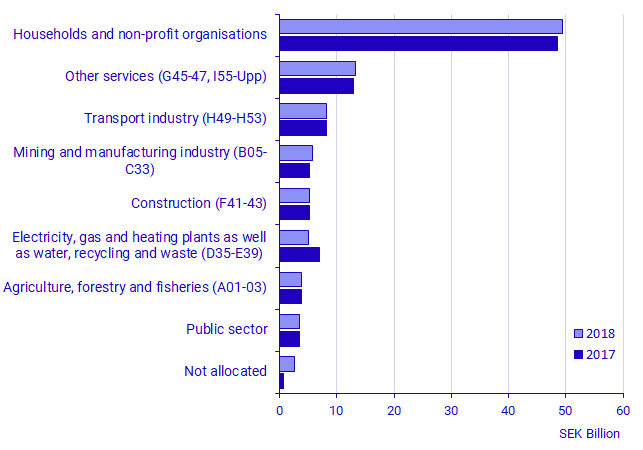Industry allocated environmental taxes in 2018
Households account for most environmental tax revenue
Statistical news from Statistics Sweden 2020-10-06 9.30
Environmental tax revenue amounted to SEK 96.9 billion in 2018, which is SEK 1.8 billion more than the previous year. In 2018, revenue from households increased by 2 percent, while revenue from the business sector decreased by 2 percent.
Total environmental tax revenue amounted to SEK 96.9 billion in 2018, which corresponds to 2 percent of Sweden’s GDP. In 2018, governmental tax revenue from environmental tax increased by SEK 1.8 billion compared with 2017.
Environmental tax is classified by industry, based on the industry that generates the revenue for central government. The tax on chemicals and the tax on air travel are not included in industry classification. Households contributed the most, SEK 49.5 billion, to environmental revenue, compared to the business sector, which contributed SEK 41.3 billion. Environmental tax revenue from both households and the business sector increased between 2008 and 2018. Environmental revenue from households increased by 10 percent, while revenues from the business sector increased by 9 percent.

Energy tax contributes most to environmental tax
Environmental tax is divided into the categories energy, transport, pollution and natural resources. Energy tax contributes the most to environmental tax and account for 76 percent of total environmental tax. Energy tax include taxes such as energy tax on fuel, carbon dioxide tax, and energy tax on electricity. This is followed by transport tax, which includes vehicle tax, congestion tax, and tax on air travel. Transport tax accounts for 22 percent of total environmental tax revenue.

Environmental tax revenue increased from households but decreased from the business sector
In 2018, environmental tax revenue from households increased by 2 percent compared with the previous year. This increase is mainly due to increased revenue from energy tax on fuel and electricity, and due to increased tax rates on these environmental taxes. In the business sector, environmental tax revenues decreased by 2 percent, mainly in the energy sector. This decrease is largely due to the fact that the tax on thermal effect expired in 2018.

Revisions
A new method for classification by industry has been implemented concerning energy tax on fuel and electricity, carbon dioxide tax, and the sulphur tax. The new classification by industry is based on energy fuel use in different industries, by type of fuel, in combination with information on tax rates and exemptions from different tax rates, and exemptions for industries included in EU’s emissions trading scheme. This means that classification by industry for separate and total energy taxes has been revised since the previous publication.
For further information on the revisions that have been made, see the Environmental Accounts product page under the heading Documentation (only available in Swedish).
Definitions and explanations
Environmental taxes
The definition of environmental tax used by Statistics Sweden was developed by Eurostat and the OECD. Today, it forms part of the international statistical standard in the SEEA Central Framework and enables comparative studies between different nations. Eurostat’s definition is:
“A tax whose tax base is a physical unit (or a proxy of a physical unit) of something that has a proven, specific negative impact on the environment, and which is identified in the European System of Accounts (ESA) as a tax.”
According to the definition, the tax base – rather than the intention or the name of the tax – determines whether the tax is defined as environmental. The ESA is a framework of guidelines for calculating national accounts used by the European Union Member States.
European statistics
Next publishing will be
The next publication on the industry allocated environmental taxes to 2019 will take place in 2021.
Statistical Database
More information is available in the Statistical Database
Feel free to use the facts from this statistical news but remember to state Source: Statistics Sweden.
